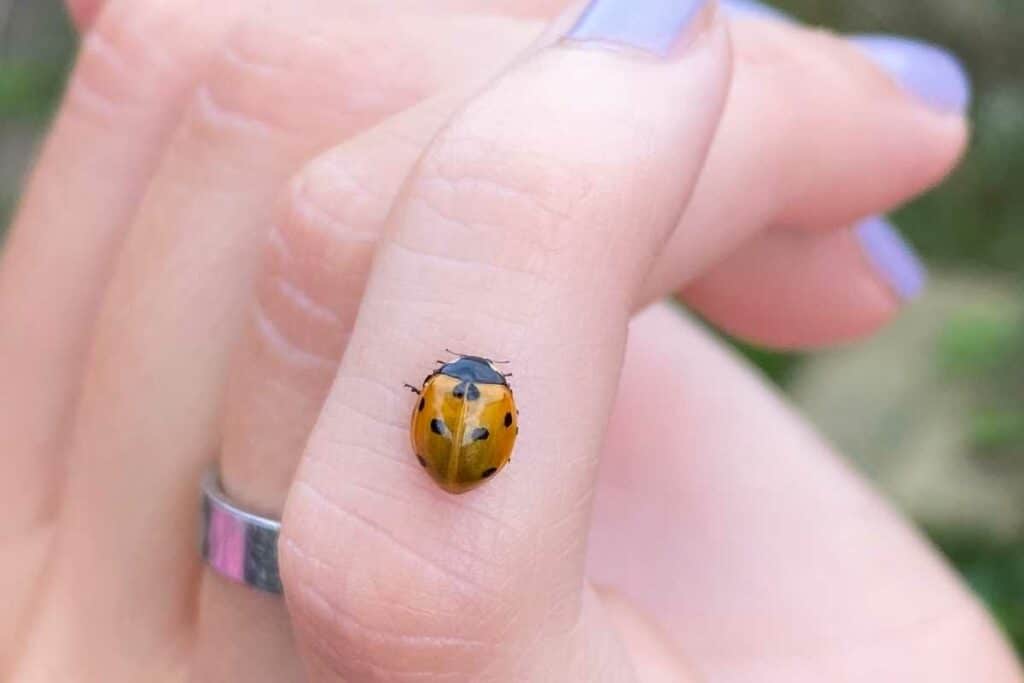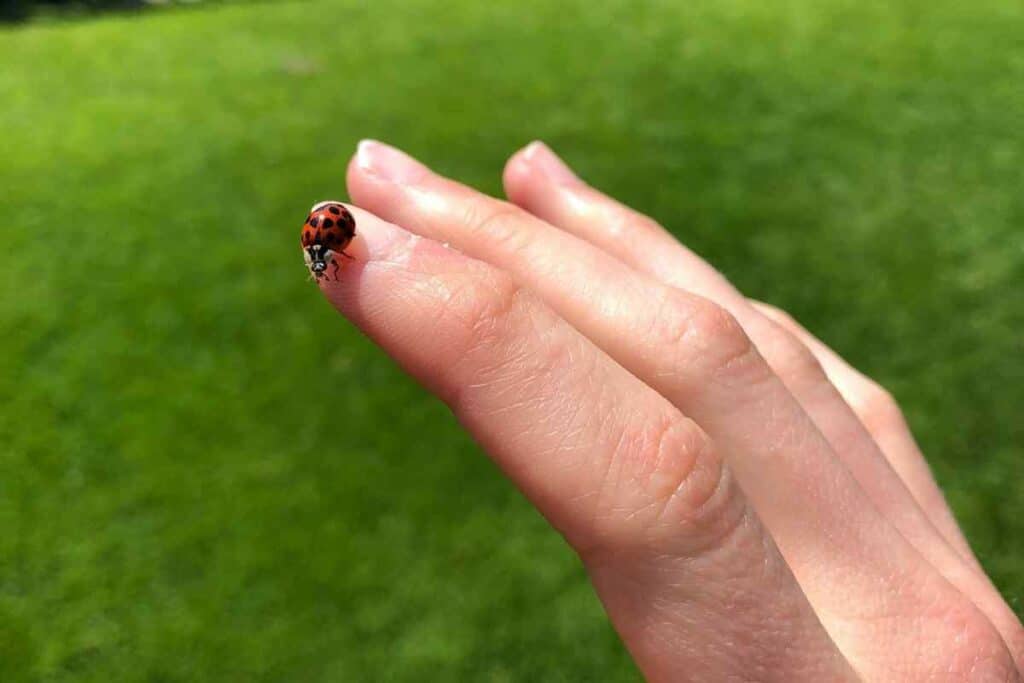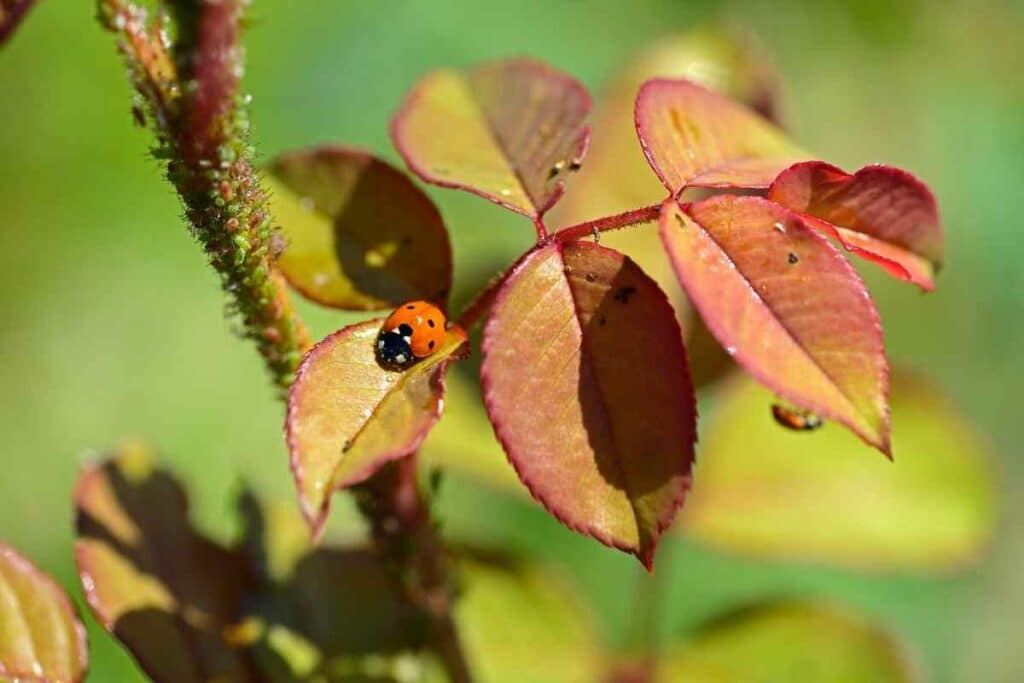Ladybugs (Coccinellids) live in a variety of green spaces including gardens, parks, meadows and woodlands. They will thrive in any environment that provides them with the small sap-sucking insects they feed on. Ladybirds also need sheltered spots like sheds trees or the underside of logs, where they can hibernate in the cooler months.
By knowing the type of habitat ladybugs need to thrive you can make your garden a haven for these cheerfully coloured beetles.
And your new residents will pay you back in driving down the numbers of pests like aphids and scale insects – perfect for organic gardening!
In This Article: We will run through everything you need to know about where ladybugs live and include some simple ideas for welcoming them to your garden.
Where Do Ladybugs Live?
Ladybugs are versatile and adaptive insects that are found in many habitats.

Where they live is usually determined by the availability of the prey species they need to survive.
This means that you can find ladybugs in habitats like:
- Grasslands
- Wildflower meadows
- Woodlands
- Wetlands
- Forests
- Gardens
- Parks
- Fields
- Hedgerows
You are most likely to encounter ladybugs that are out and about in the spring and through to autumn when they are active.
As the weather cools, they will seek somewhere warm to overwinter.
Ladybug Habitats Support the Ladybug Lifecycle
The habitat of ladybugs is critical to the ability of these insects to reproduce and overwinter.
Mature females will ideally lay their eggs on plants that mealybugs, scale insects or aphids have colonised.
When the spiny, black and spotted larvae of the ladybug hatch, they attack and feed off the pests until they are ready to pupate.
Pupation of ladybug larvae takes place on the leaves of plants, with adult ladybirds also preying on pests and flying off to find further food sources.
The reproductive process is continual during the spring and summer months with several generations being hatched within a single year.
With colder weather comes the need for the ladybugs to search for a warm location to overwinter.
Did You Know? When they find a suitable nesting area, under leaves, rocks or cracks in masonry, ladybugs can gather in large numbers until spring.
Benefits of Making Your Garden a Ladybug Habitat
The presence of ladybugs in your backyard or garden is a sign of a healthy ecosystem.
There are only a few species of ladybug that are pests, and overall they contribute massively to keeping pest species at bay and your plants healthy.
Here are two key benefits of welcoming ladybirds to your garden.
1. Ladybugs Are the Natural Predators of Sap-feeding Pests
One of the biggest benefits of having ladybirds in your garden is their efficiency as predators of the common garden pests that can weaken or destroy your plants and crops.
A single ladybird can devour over 5,000 aphids in its lifetime and will also lay its eggs among mealybug or aphid colonies so that their larvae can feed off these pests when they hatch.
Here are some of the species that are predated by the ladybug:
- Scale insects
- Mites
- Spider mites
- Lacewings
- Thrips
- Whitefly
- European corn borer
- Caterpillars
- Beetle larvae
- Insect eggs
2. Ladybugs Are Also Great Pollinators
Ladybirds were always thought to be purely carnivorous beetles, but in recent times it has been found that their diet is far more varied.

Even arch-hunters have been found to consume pollen and other plant matter. And considering their predilection for aphids, they also consume honeydew too.
plant and flower related feeding activity mean that ladybugs are also contributing to the pollination of plants and trees as they move among them.
Attracting Ladybugs to Your Garden Will Help Them Thrive
If you are a keen gardener or grower, you will want to have ladybug species onside.
Making your home a suitable habitat for ladybirds will not only benefit your garden but also help native species of ladybirds to flourish.
In the UK, the number of native species of ladybirds has been declining. This is thought to be because of habitat loss, environmental changes and increasing numbers of invasive species which can out-compete the native 10-spot and 14-sport ladybirds.
Populations of specific species of ladybirds have shifted across the UK as a whole.
One of the biggest impacts on native British ladybirds was the arrival of the Asian harlequin, a ladybug from Europe that was deliberately introduced to control pests in 2003 and has since become invasive.
Providing a habitat that is suitable for ladybirds in your garden will help native species recover.
Here’s How You Can Make Your Garden a Ladybug Habitat!
Learn to recognise ladybugs and their developmental stages.
This can help you differentiate these beneficial insects from pests that you may want to remove or destroy.
Insecticide use can not only decimate your local ladybug population but also harm beneficial pollinators that are needed for your plants and crops.
Only use insecticide preparations as an intervention of last resort, with targeted applications for the minimum necessary duration.
Plants that provide pollen and nectar for ladybugs to feed on are always a plus!
Plants that attract ladybirds include:
- Yarrow
- Feverfew
- Marigold
- Calendula
- Sunflower
- Sweet alyssum
- Dill
- Fennel
- Angelia
- Bugleweed
- Cosmos
- Chives
- Caraway
- Dandilions
Providing warm sheltered areas for ladybugs to overwinter will mean that they will stay in your garden year after year!

More and more gardeners recognise the benefit of providing places where insects can overwinter.
You may have heard of bug hotels that provide the perfect crevices for ladybugs and other insects to crawl into and shelter in.
In autumn, leave some piles of leaf litter for ladybirds and other insects.
Right Thing to Do: Overgrown vegetation, leaf litter and even an old shed will provide the pockets of warmth that a ladybug can use to survive the frosts.
Rounding Up
Ladybugs can make a home of just about anywhere where their diet of aphids and other prey can be satisfied.
These colourful beetles are well worth inviting to your garden as they will protect your crops and ornamentals from pests and pollinate your plants.
Also Read
- Where Do Japanese Beetles Go at Night?
- Can Spider Mites Live on Humans? Do They Bite?
- Do Butterflies Drink Blood?